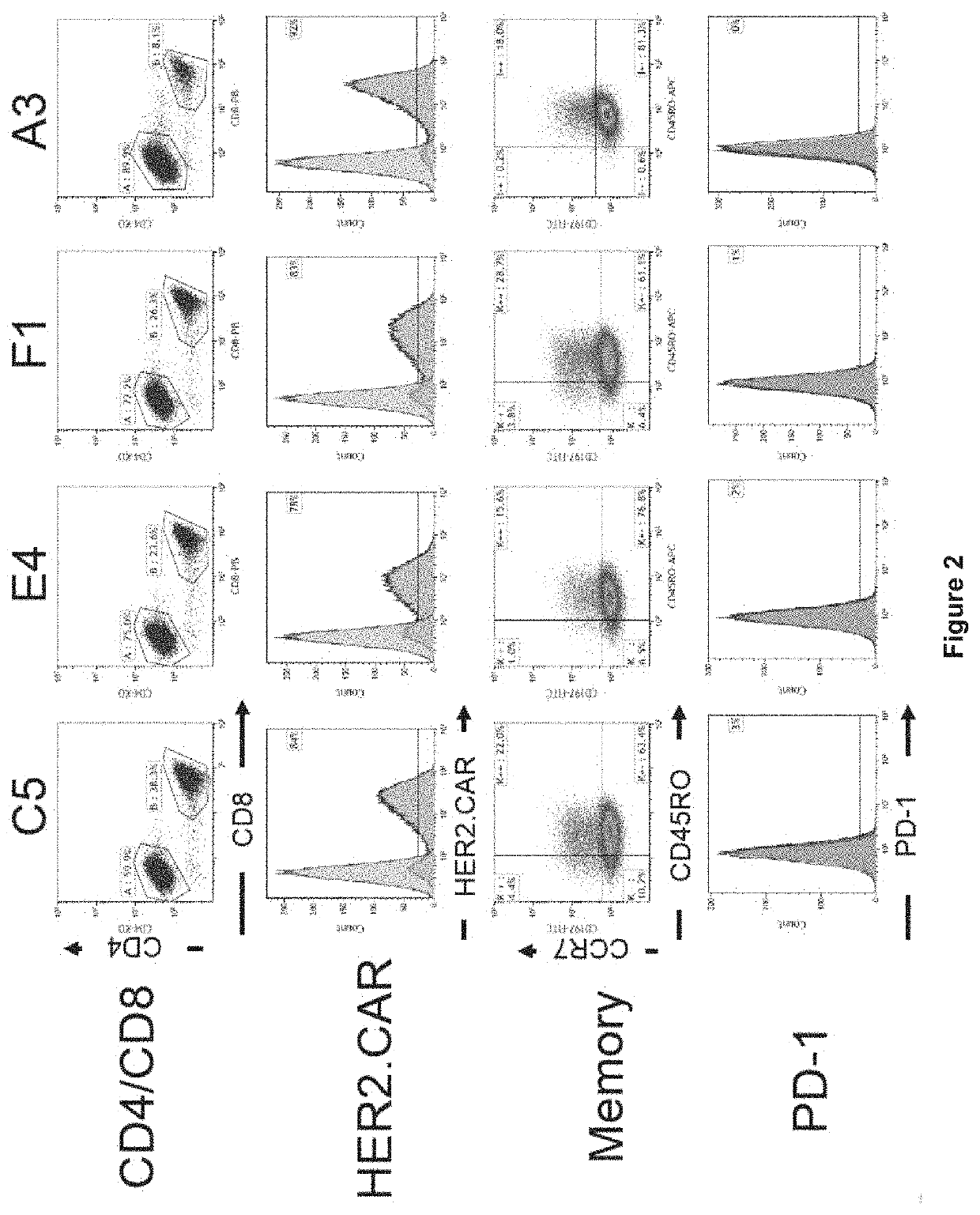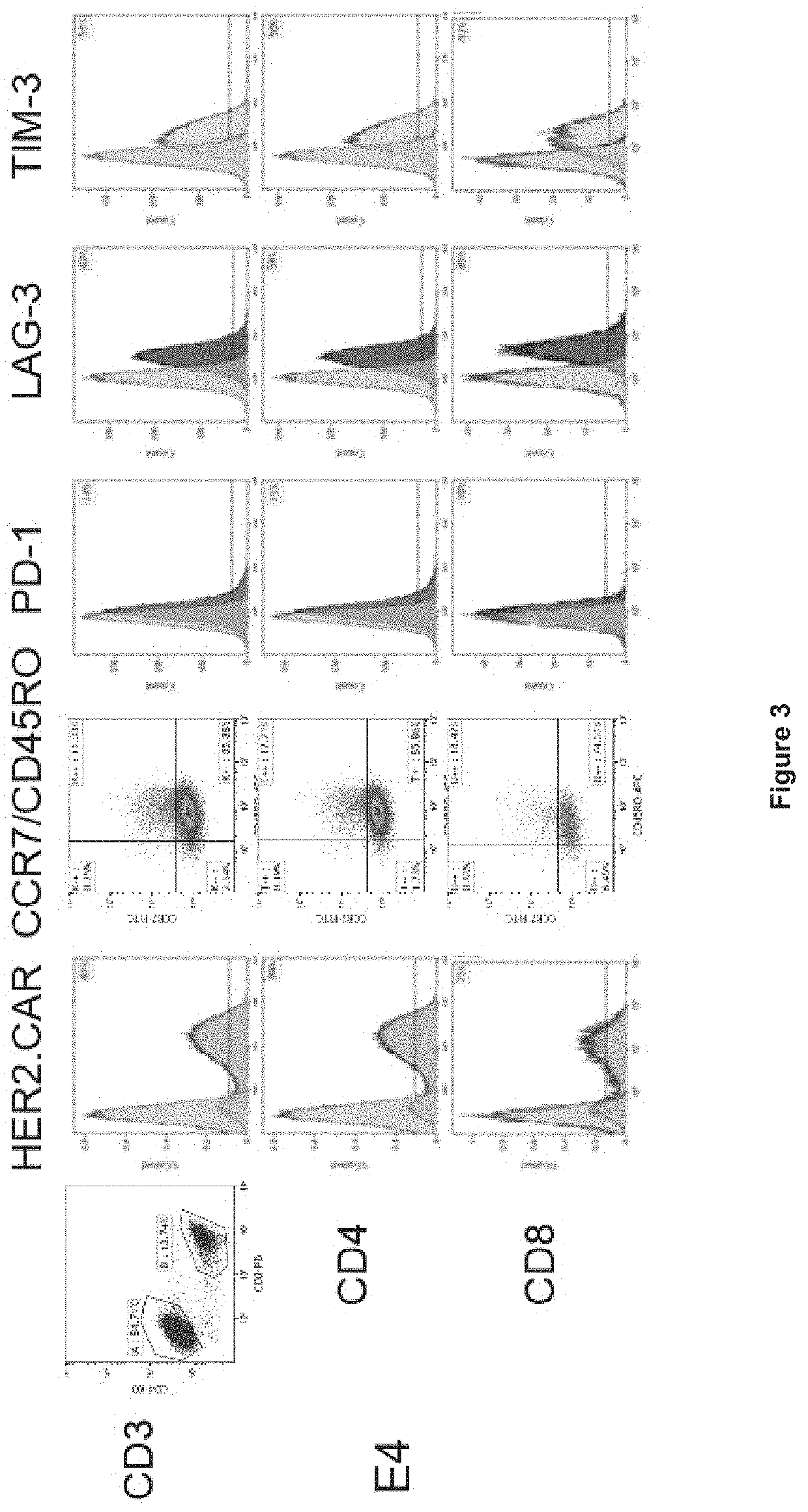Oncolytic virotherapy and immunotherapy
a technology of immunotherapy and oncolytic virotherapy, applied in the field of cell biology, molecular biology, immunology, medicine, can solve the problems of limited treatment of locally advanced hnscc, failure to show improvement in overall survival, and limited transgene coding capacity of oncads
- Summary
- Abstract
- Description
- Claims
- Application Information
AI Technical Summary
Benefits of technology
Problems solved by technology
Method used
Image
Examples
example 1
ific CAR-T Cells
1.1 Generation of HER2-Specific CAR Constructs and CAR-T Cells
[0490]HER2-binding CAR constructs were prepared. Briefly, DNA encoding scFv (i.e. VL domain and VH domain joined by a linker sequence) for the anti-HER2 antibody clone C5. E4, F1 or A3 was cloned into a CAR construct backbone comprising a 5′ signal peptide (SP), and CD28 transmembrane (TM) and intracellular domain sequence, with a 3′ CD34 intracellular domain sequence. The three HER2-binding CAR constructs are represented schematically in FIG. 1A.
[0491]HER2 specific CAR-T cells were generated as represented graphically in FIG. 1B. Briefly, human PBMCs were isolated from blood samples by with Ficoll density gradient centrifugation. Cells were treated by stimulation with anti-CD3(OKT3) / anti-CD28 in the presence of IL-2 to promote T cell activation and proliferation, and the cells were transduced with retrovirus encoding the HER2 CAR constructs. T-cells were expanded by culture in the presence of 100 IU / mL re...
example 2
structs
2.1 Generation of OncAd Constructs
[0500]Novel constructs encoding oncolytic adenovirus are prepared using recombinant DNA techniques.
[0501]In particular embodiments, an OncAd is produced upon modification of a known virus. For example, a region encoding E1A protein from adenovirus 5, such as one lacking the sequence LTCHEACF (SEQ ID NO:52) involved in binding the Rb protein, is replaced with sequence encoding E1A protein from adenovirus 2, similarly lacking the sequence LTCHEACF (SEQ ID NO:52).
[0502]ICOSTAT shown in FIG. 6 was produced from ICOVIR15 disclosed e.g. in Rojas et al. 2010 Mol Ther 18 1960-1971. Briefly, the region of ICOVIR15 encoding eight copies of a binding site for the transcription factor E2F was replaced with a region encoding eight tandem copies of a binding site for the transcription factor STAT1. The sequence of ICOSTAT is shown in SEQ ID NO:51.
[0503]Onc5 / 3Ad2E1Δ24 (also referred to herein as “Onc5 / 2E1Δ24” shown in SEQ ID NO:55 and represented schematica...
example 3
pendent Ad (HDAd) Constructs
3.1 HDAd Constructs and Production
[0514]A novel construct encoding a helper-dependent adenovirus was prepared using recombinant DNA techniques. The coding sequence of the resulting construct designated HDAdIL-12_TK_PD-L1 is represented schematically in FIG. 10A. HDAdIL-12_TK_PD-L1 contains sequence encoding expression cassettes for (i) human IL-12p70 (sequence encoding alpha and beta chains), (ii) HSV-1 thymidine kinase, and (iii) an anti-PD-L1 minibody (comprising the CDRs of anti-PD-L1 clone H12_gl described e.g. in WO 2016111645 A1) including a HA tag. The three coding sequences each have their own polyA signal sequences.
[0515]The HDAd HDΔ28E4EGFP construct containing an EGFP transgene driven by the CMV promoter (HDAdeGFP) was produced as described in Farzad et al. Oncolytics 2014 1: 14008.
[0516]The HDAd “HDIL12_PDL1” contains sequence encoding human IL-12p70 protein and anti-PD-L1 minibody derived from YW243.55.S70 (atezolizumab). The anti-PD-L1 minib...
PUM
| Property | Measurement | Unit |
|---|---|---|
| Fraction | aaaaa | aaaaa |
Abstract
Description
Claims
Application Information
 Login to View More
Login to View More - R&D Engineer
- R&D Manager
- IP Professional
- Industry Leading Data Capabilities
- Powerful AI technology
- Patent DNA Extraction
Browse by: Latest US Patents, China's latest patents, Technical Efficacy Thesaurus, Application Domain, Technology Topic, Popular Technical Reports.
© 2024 PatSnap. All rights reserved.Legal|Privacy policy|Modern Slavery Act Transparency Statement|Sitemap|About US| Contact US: help@patsnap.com










